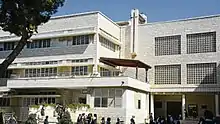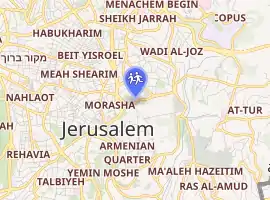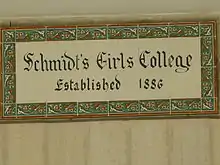Schmidt's Girls College
Schmidt's Girls College[1] (SGC; German: Schmidt-Schule Ost-Jerusalem; Arabic: كلية شميدت) is an international German school for Christian and Muslim girls,[2] located in East Jerusalem.[3] It was founded in 1886 and approximately 500 pupils attend the school today. It includes a grundschule (primary school) program,[4] as well as the Deutsche Internationale Abiturprüfung (DIAP, German International Abitur) program.[5] It also offers a Tawjihi program. Although it is owned and supported by the German Association of the Holy Land, it is currently in the care of the international convent of the Sisters of the Congregation of Jesus. Lessons are taught in German and the spoken language outside of class is English. The teaching staff is composed of both Arab and German teachers.
| Schmidt's Girls College | |
|---|---|
 | |
| Location | |

| |
Israel | |
| Information | |
| Established | 1886 - 1914, 1915 - 1918, 1921 - 1948, 1950 -1967, 1967 - |
| Closed | 1914 - 1915, 1918 - 1921, 1948 - 1950, 1967 - 1967 |
| Grades | Kindergarten - High school |
| Age range | 5-17 |
| Enrollment | approx.500 |
| Website | schmidtschule |


History
In 1886 a school for Arab girls was established in the Mutasarrifate of Jerusalem, then part of the Ottoman Empire, in the newly built Old Hospice near the Jaffa Gate next to a pilgrims’ hospice and a medical station. The school and the medical station were under the care of a convent of the Catholic sisters of St. Carl Borromaeus. In 1890, the German Lazarist Father Friedrich Wilhelm Schmidt took on the administrative role of the school. The pupils’ numbers grew from 36 in 1890 to approximately 120 in 1914 and to 138 in 1915. The syllabus followed the learning plans of German state schools.
During Kaiser Wilhelm II's journey through Palestine, he also paid a visit to the Schmidt's Girls College. At a meeting with him, Wilhelm Schmidt suggested building a new bigger and more suitable accommodation for pilgrims. The Kaiser had already supported the construction of the Lutheran Church of the Redeemer in Jerusalem and the establishing of the Abbey of the Dormition on Mount Zion. With his support, the German Association of the Holy Land acquired two parcels directly opposite the Damascus Gate in Jerusalem where they built the Paulus-Haus. After Schmidt died in 1907, the administrative role was passed on to Father Ernst Schmitz who continued building the library and expanded the natural sciences collections. The pilgrims’ hospice moved into the new building in 1908 where a teachers’ seminar was also established. As a result, more teaching space became available in the old hospice.
At the start of the First World War the school was initially closed, like all other international institutions, but it resumed activity at the start of 1915 due to the good relations between Germany and the Ottoman Empire. The only requirement was to include Turkish as a teaching language. After the capture of Jerusalem by the British forces in 1918 the college closed down for three years. When it reopened, under the British Mandate of Palestine, English replaced German as the main teaching language. However, German was later used again. By adopting Palestinian learning plans, the pupils could receive Palestinian certificates of secondary education alongside their German ones, as well as take a teaching exam. Initially, the college taught 27 pupils split between two classes and a kindergarten group. Because of the small number of female pupils, boys were also accepted until 1930. By 1936 the student body had increased to 370.
German became an obligatory foreign language from the sixth grade onwards in the 1930s. A German division was composed of two classes of German students taught according to German syllabuses.
At the start of the Second World War the German teachers were deported, including the head of the school, Sister Maria Kramm, who was replaced by the Arab Sister Elia. The German teaching staff returned in 1943 and the school remained active until May 1948. The old hospice in Hillel Street, used as a school building, lay in the western Israeli part of Jerusalem after the ceasefire agreement of 1949. However, the students mainly lived in East Jerusalem, then under Jordanian administration. As a result, the school was moved into the Paulus-Haus on 1 October 1950. The headmaster, Father Sonnen, was able to achieve the move quickly through the support of the Israeli authorities, enlisting the help over 60 vans for the transportation purposes. Three years later the school had approximately 400 students.
In the 1950s several new buildings were constructed and in 1962 the construction of a new school site began on the land next to the Paulus-Haus. Although it was completed on 14 May 1967, the Six-Day War began only a few days later, during which the new building suffered heavy external damage.
Academic overview
The twelve-year school period finishes with the Palestinian Tawjihi certificate and the Deutsche Internationale Abiturprüfung (DIAP, "German International Abitur Program"). The abitur is recognized by the Palestinian education authorities and enables applying for higher education in Germany, Palestine and worldwide. Almost 100% of Schmidt's College students continue onto university. The Schmidt's Girls College is considered a prestigious institution and graduates are in demand by employers. The college is under the care of the convent of the Sisters of the Congregation of Jesus, amongst other organisations.
The college is a Catholic school following the Corpus Iuris Canonici (lit. "Body of Canon Law") and highlights the requirements of the Gravissimum educationis. It still follows German traditions and has a close connection to the German educational environment. At the same time it is a school in a predominantly Muslim region. This is reflected in the student body composition of 80% Muslim and 20% Christian students, which is the opposite of the teaching staff composition.
References
- "Home." Schmidt's Girls College. Retrieved on 23 January 2015. "Student at Schmidt's Girls College today, leader tomorrow!"
- "Schule." Schmidt-Schule Jerusalem. Retrieved on 23 January 2015.
- "Kontakt." Schmidt-Schule Jerusalem. Retrieved on 23 January 2015. "Nablus Road 2 P.O. Box 19070 East-Jerusalem via Israel"
- "Herzlich Willkommen auf der Grundschulseite der Schmidt Schule in Ost-Jerusalem." Schmidt-Schule Jerusalem. Retrieved on 23 January 2015.
- "Information on the German International Abitur (DIAP)." Schmidt-Schule Jerusalem. Retrieved on 23 January 2015.
Further reading
- Margret Greiner: "Miss, wie buchstabiert man Zukunft?" : als deutsche Lehrerin in Jerusalem. München : Malik, 2003 ISBN 3-89029-256-9
External links
| Wikimedia Commons has media related to Schmidt's College. |